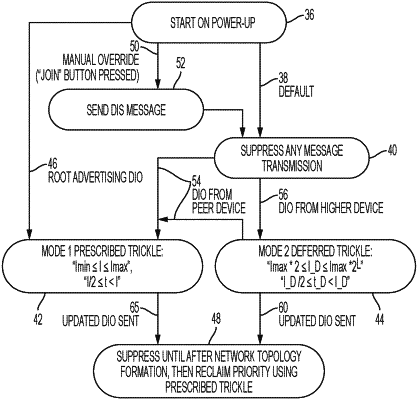| CPC H04L 43/16 (2013.01) [H04L 41/12 (2013.01); H04L 43/0882 (2013.01); H04L 45/121 (2013.01)] | 18 Claims |

|
1. A method comprising:
joining, by a network device, a network topology rooted by a root network device in a data network, and in response to transmitting an advertisement indicating a position of the network device in the network topology;
suppressing, by the network device, a second transmission based on initiating a deferred transmission operation in response to transmitting the advertisement;
maintaining, by the network device, the deferred transmission operation for at least a prescribed deferral interval that enables at least a prescribed minimum number of other network devices to join the network topology at respective identified lower positions than the position of the network device; and
changing, by the network device, from the deferred transmission operation to an accelerated operation in response to one of expiration of the prescribed deferral interval or detecting the prescribed minimum number of other network devices having the respective identified lower positions, the accelerated operation enabling the network device to initiate transmission of a data packet before the other network devices,
wherein the network device suppresses the second transmission in response to detecting a third transmission from one of the other network devices having the identified position lower than the position of the network device, and
wherein the maintaining includes repeating, during the deferred transmission operation, waiting for at least a corresponding deferred transmission interval in response to detecting a message from a corresponding one of the other network devices.
|